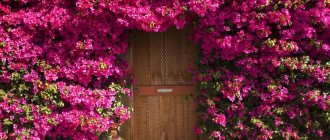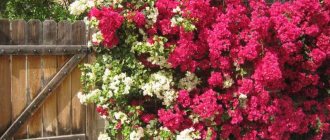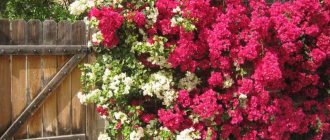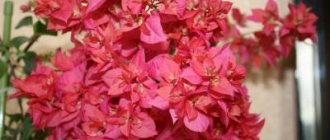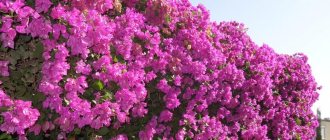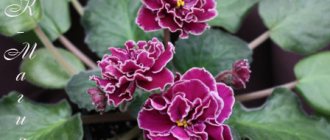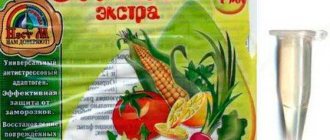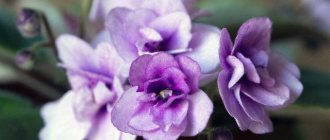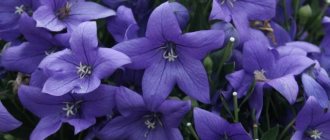Skip to content
Instagram VK
Tel. 8-996-686-71-22 (VIBER, WhatsApp). Email: [email protected]
Cvetovod86 cuttings and flower seedlings
Search
Cart / 0 ₽ 0
Cvetovod86 cuttings and flower seedlings
Instagram VK
Cart / 0 ₽ 0
250 ₽
Bougainvillea “louise walton red” - rooted cuttings for spring 2022
Available for pre-order
SKU: 0119 Category: bougainvillea Tags: bougainvillea, Bougainvillea “louise walton red”
- Description
- Reviews (0)
Bougainvillea "louise walton red" - bright crimson-red flowers.
The plant has a dense stem. As it grows, the stem becomes woody. The presence of thorns (not many) and liana-like branches on the stems allows the plant to cling to supports. Needs molding. The branches are abundantly covered with foliage. The leaves are small. Up to 5 cm in diameter.
Needs good lighting. Not afraid of direct sunlight. Does not tolerate temperature changes. Doesn't like moving from place to place.
Wintering required. The temperature during this period should be 15 degrees. BUT an important point is lighting. It should be the same as during the flowering period. Watering during the dormant period is not abundant.
Bougainvillea by variety
Bougainvillea - discussion and photos of varieties
- 1 Replies 927 Views Last post by Evgeniya_kst 09 May 2021, 18:36
- 9 Replies 3526 Views Last post by Petrovna4ka Mar 22, 2021, 9:14 pm
- 219 Replies 19574 Views Last post by nalya 13 28 Jan 2021, 12:56
- 5 Replies 1816 Views Last post Liudmila 27 Dec 2020, 19:43
- 6 Replies 2573 Views Last post by viniti Oct 18, 2022, 07:14 pm
- 16 Replies 2743 Views Last post Liudmila 19 Sep 2020, 19:42
- 1 Replies 1451 Views Last post Liudmila 19 Sep 2020, 18:46
- 16 Replies 4878 Views Last post Liudmila 19 Sep 2020, 18:41
- 19 Replies 3598 Views Last post by Petrovna4ka 04 Sep 2020, 20:56
- 1 Replies 873 Views Last post Liudmila 21 Aug 2020, 17:29
- 15 Replies 3548 Views Last post Dymka 17 Jul 2022, 09:29
- 1 Replies 767 Views Last post Liudmila 01 Jul 2020, 22:01
- 2 Replies 1037 Views Last post Liudmila 24 Jun 2020, 18:24
- 8 Replies 2555 Views Last post by Kasandra May 24, 2020, 01:35 pm
- 6 Replies 2376 Views Last message Elena Matsenkova Apr 06, 2022, 09:29 pm
- 1 Replies 1027 Views Last post by nalya 13 02 Feb 2020, 22:13
- 1 Replies 1624 Views Last post by olya.k Jan 25, 2022, 4:29 pm
- 15 Replies 3637 Views Last post Responsive 19 Jan 2020, 09:18
- 9 Replies 2377 Views Last post Liudmila 07 Dec 2019, 22:04
- 5 Replies 1917 Views Last post by nalya 13 12 Nov 2019, 12:48
- 7 Replies 2039 Views Last post by Petrovna4ka 07 Nov 2019, 07:32
- 8 Replies 2173 Views Last post by viniti 06 Nov 2022, 10:42
- 6 Replies 2928 Views Last post by viniti 06 Nov 2022, 10:31
- 1 Replies 1131 Views Last post by viniti 06 Nov 2022, 09:50
- 1 Replies 1523 Views Last post by viniti 06 Nov 2022, 09:46
- 6 Replies 2621 Views Last post by viniti 06 Nov 2022, 09:41
- 3 Replies 1832 Views Last post by viniti 06 Nov 2022, 09:38
- 3 Replies 1725 Views Last post by viniti 06 Nov 2022, 09:35
- 4 Replies 1556 Views Last post by viniti 06 Nov 2022, 09:28
- 12 Replies 3746 Views Last post by viniti 06 Nov 2019, 09:26
- 2 Replies 1625 Views Last post by viniti 06 Nov 2022, 09:23
- 7 Replies 3347 Views Last post by viniti 06 Nov 2022, 09:19
- 7 Replies 3331 Views Last post by viniti 06 Nov 2022, 09:17
- 11 Replies 2674 Views Last post by viniti 06 Nov 2019, 09:14
- 5 Replies 2045 Views Last post by viniti 06 Nov 2022, 09:04
- 8 Replies 2719 Views Last post Liudmila Apr 27, 2019, 10:29 am
- 2 Replies 1787 Views Last post by Helena Helena Apr 19, 2022, 10:24 pm
- 4 Replies 1751 Views Last message Elena Matsenkova May 28, 2022, 04:09 pm
- 0 Replies 1639 Views Last message Elena Matsenkova Apr 06, 2022, 05:10 pm
- 9 Replies 1986 Views Last message Elena Matsenkova Mar 20, 2022, 09:44 pm
- 18 Replies 3274 Views Last message Elena Matsenkova March 20, 2022, 21:40
- 7 Replies 1915 Views Last message Elena Matsenkova Mar 12, 2022, 4:49 pm
- 2 Replies 2025 Views Last post datura 03 Mar 2022, 11:56
- 6 Replies 1834 Views Last post by viniti 01 Mar 2022, 21:24
- 2 Replies 1531 Views Last post by viniti 01 Mar 2022, 20:39
- 1 Replies 1776 Views Last post by aglara 01 Mar 2022, 13:34
- 1 Replies 1429 Views Last post by aglara 02 Feb 2022, 13:25
- 2 Replies 1820 Views Last post by Svetlana55 15 Nov 2017, 06:12
- 0 Replies 1828 Views Last message Elena Matsenkova Oct 18, 2022, 10:18 pm
- 1 Replies 1856 Views Last message Elena697 04 Jul 2017, 23:28
Access rights
You cannot start topics You cannot reply to messages You cannot edit your messages You cannot delete your messages You cannot add attachments
Beneficial properties of bougainvillea
Flower cells secrete phytoncides - biologically active substances that cleanse the air space of harmful microorganisms. In rooms where the plant blooms, people's performance increases, anxiety levels decrease, and sleep improves. The flower attracts positive energy and generously shares it with others.
It is believed that bougainvillea helps to attract good luck and material well-being to all signs of the zodiac, only Sagittarius does not enjoy the favor of the plant. Blooming bougainvillea creates a pleasant atmosphere in the house.
IMPORTANT INFORMATION
All plants presented on the site are approximately one year old, with developed roots.
Here is a sample of the plants being sent, all plants in a 10 cm high pot.
Before shipping, I cut off the bracts so that the plant adapts faster after the journey.
Delivery is carried out only on the territory of the Russian Federation by Russian Post, transport company or bus to the nearest regions.
You can calculate the delivery cost yourself on the Russian Post website, indicating the city and weight. We are located in Gulkevichi, the weight of one pot is approximately 280 grams.
Below is a catalog with assortment and prices. To place an order, write a list of plants to me on WhatsApp at 8-999-655-65-00 or on Instagram.
Bougainvillea is a Brazilian beauty on Siberian window sills. Content secrets
This wonderful plant was discovered in Southern Brazil three centuries ago. During this time, bougainvillea has taken its rightful place in the hearts of all connoisseurs of beauty, and now we can admire it on the streets of warm corners of the earth and on our own windowsills. The genus Bougainvillea has fourteen main species, mostly vines. The most common two species are Bougainvillea naked (B. glabra), Bougainvillea wonderful (B. spectabilis). Well, there are many subspecies! With red bracts, with white bracts, with two-colored and tricolored ones, there are double ones, with variegated leaves, there are dwarf ones, and there are also trees! The variety of bract colors is simply amazing. As daylight decreases, bougainvillea sheds most of its leaves, leaving woody branches and stems bare, but this does not stop the plant from blooming! This is where the name “naked” came from.
Bougainvillea is a strong, heat-loving plant that responds gratefully to flowering care even in the harsh climate of Siberia. The secrets of growing bougainvillea are simple, and even novice gardeners can handle it.
Terry varieties of bougainvillea
Terry varieties are famous for their particularly dense caps at the ends of the shoots and exceptional decorativeness. Photos of bougainvillea from the Double varietal group, which includes plants with white, salmon, pale pink, purple, red and orange stipules, are always a reason for the admiration and envy of many gardeners.
The bougainvillea variety Double Lilarose has amazingly sensual shades of pink, salmon and lilac combined with a long flowering period and relative unpretentiousness. Also interesting is Boogervillea Double Pink, which differs from the first representative of the group in more delicate tones and a slightly greenish base of the stipules.
The luxurious caps of juicy crimson bracts on Double Red bougainvillea will be a discovery for beginning gardeners and will not leave connoisseurs of this tropical crop indifferent.
Double flowering is not the limit of the possibilities of a unique flower.
Bougainvillea spectabilis
This type of plant is characterized by an incredible growth rate and often looks like a large vine, up to 15 meters high. Like all types of bougainvillea, the leaves of this variety have a heart-shaped, pointed shape. The back side is covered with a small pile, the autumn leaf plates are dense and durable. In the photo of bougainvillea, in addition to leaves and curved thorns, bright bracts are clearly visible. Bougainvillea flowers, opening from April to mid-autumn, are collected in paniculate inflorescences at the ends of the branches. A group of two or three stipules surrounds 1 to 3 true flowers.
Descriptions and photos of popular bougainvillea varieties
In the tropics and subtropics of South America, where bougainvillea grows, the crop can climb to a height of many meters and entwine the walls of houses.
Some varieties of this spectacular plant take the form of lushly flowering trees, covered with the thorns of powerful vines or modest shrubs. In warm climates, the tops of the shoots are covered with flowers almost all year round. True, the corollas of real bougainvillea flowers can only be seen close up, and the multi-colored caps in which the foliage and stems are buried are modified leaves. Bracts vary in color, shape and size. There are two-color varieties, as well as plants in which the color of the bracts changes in intensity or tone over time. Of the bougainvillea species existing in nature, the most popular among lovers of ornamental plants are beautiful bougainvillea and naked bougainvillea. In addition, there are a lot of interspecific hybrids, as well as cultural forms and varieties of the most amazing colors.
Conditions for Tropicana (table)
How to organize summer maintenance?
In the southern regions, bougainvillea is a garden plant. In the wild, a flowering tropicana has everything she likes: plenty of space to grow, sun, fresh air and soil. In a harsher climate, bougainvillea is not averse to spending at least the summer outside. And it’s great if you have the opportunity to send it to the garden or country house. Russian lovers of this plant talk about the positive results of such “vacations”. Bougainvillea pots without pallets are placed directly in the garden. The roots go into the ground through drainage holes. The growth over the summer can be half a meter. When kept this way, bougainvilleas feed with their neighbors in the garden. The tropical beauty perfectly absorbs organic matter, for example, a solution based on horse manure. Flower growers are divided from such feeding of plants “like horses.”
Bougainvillea has a quirk: it does not take well to changing places. You should not move the pot from room to room without special need or rotate it so that the light falls evenly. It is especially important not to disturb bougainvillea during bud formation and flowering. From stress, it can begin to fall leaves. Determine a permanent place for the plant, taking into account its needs and do not touch it.
Bougainvillea does not like changing place or pot.
Photo of bougainvillea with colorful bracts
Today, lovers of indoor and garden floriculture have at their disposal varieties that fully reveal the ability of the bracts of this plant to change color over time.
The bracts of bougainvillea variety Bois De Roses are orange at first, but gradually change color, becoming deep pink. A similar picture is observed during flowering of the Thai Gold variety. This bougainvillea shown in the photo appears golden-orange in the first days, but as the bracts fade, they become completely blush-pink.
Similar metamorphoses occur with many plant varieties and hybrids. Initially white bracts take on pink tones, red-orange ones become crimson or purple. By skillfully combining specimens with such extraordinary properties, you can turn your garden into something constantly changing, but always beautiful.
Even more surprising are bougainvillea varieties on which two-color bracts appear simultaneously or on different branches their shades differ significantly.
Strawberry Lace is a plant with white and pink stipules that can only be compared to fresh strawberries and cream. On the stipules of bougainvillea Mary Palmer the shades are more delicate and blurred. On a basic white background, strokes of lilac and lavender look very beautiful.
If you want to buy bougainvillea in a pot
It is better to buy bougainvillea (like any indoor flowers) in stores rather than in markets—indoors create more favorable conditions for flowers. Take your time and carefully inspect the plant: there should be no spots on the leaves and bracts, wet rotting areas, dry tips and, of course, no insect pests. The plant should not be drooping or withering. A strong flower will better withstand a change of environment.
Immediately choose a permanent place for bougainvillea: this plant has a very negative attitude towards change and rearrangement. For this reason, immediately after purchase, it can shed a significant amount of foliage and flowers. There is no need to worry - soon the plant will get used to the new place and quickly recover.
The price of indoor bougainvillea in the store starts from 350 rubles per copy. These are small plants that you have to grow yourself. You can also purchase large adult plants, whose decorative value is high, as well as their financial value. In particular, a tree 160 cm high, which can decorate both a house and a summer cottage, can cost 36,000 rubles. The price of a mature and large bougainvillea in the form of a liana will be half as much - about 15,000 rubles.
If the roots of a newly purchased plant are visible through the drainage holes in the pot, the bougainvillea should be replanted immediately, even though it is blooming. In this case, the flowers will have to be removed.
Variegated varieties of bougainvillea
A special place is occupied by varieties that, in addition to bright and sometimes multi-colored bracts, also have two shades combined on the foliage.
Most of these plants are the result of a spontaneous mutation, so offspring can only be obtained from them vegetatively using cuttings and layering.
Bougainvillea San Diego Red Variegata has red bracts that look even more striking against the background of light golden-green foliage. The salmon or golden bracts of bougainvillea variety Delta Dawn look like real gold against the background of bluish-green foliage with a bright white border.
In addition to golden or white spots on bougainvillea leaves, you can also see pink tones. An example of this is the beautiful Raspberry Ice variety with carmine bracts and decorative foliage, as if toasted along the edges.
Sources:
https://vk.com/wall-101209780_668 https://dom.sibmama.ru/bugenvilja.htm https://glav-dacha.ru/opisaniya-i-foto-sortov-bugenvillii/
Bougainvillea: where it grows in Russia
Bougainvillea roots have very low frost resistance; a temperature drop below +5 °C is destructive for them. Therefore, the plant is not able to survive in the harsh climate of our homeland. In open ground in Russia it is grown only on the Black Sea coast of Crimea and the Caucasus. And even in these regions, it is recommended to cover the plant for the winter.
In central Russia and the Urals, such a heat-loving plant can only be grown in greenhouse conditions, as a tub plant or, with proper care and maintenance, in an apartment. Among other things, bougainvillea is often used as a bonsai plant.
Now Bougainvillea has settled in the tropical and subtropical zones throughout the globe. It grows where the temperature does not drop below +5 degrees. This colorful vine is a favorite plant of landscape designers.
Bougainvillea glabra
This type of bougainvillea, in the photo, is much smaller. Its maximum height is only five meters, which makes it possible to use the plant as an indoor crop. This is facilitated by the fact that the plant tolerates pruning almost painlessly and can be shaped at the owner’s request.
An example of this is the Bougainvillea Sanderiana shown in the photo, an old variety tested by gardeners around the world.
Unlike beautiful bougainvillea, this species has completely smooth leaves, and blooms in spring and early summer. The range of colors is incredibly wide, which is facilitated by active breeding work. It was bougainvillea glabra, cultivated back in 1861, that became the basis for obtaining a great variety of hybrid and varietal plants that today decorate gardens, parks and window sills.
Another variety is bougainvillea Alexandra, ideal for compact indoor compositions and creating original garden sculptures. True, in Russian conditions in open ground this beautiful vine takes root only in the southern regions, since it does not tolerate frosts below -8 °C.
Description of the flower
Bougainvillea belongs to the Noctiflower or Nyctaginaceae family. In its homeland, in South America, Bougainvillea is found everywhere in the form of flowering shrubs or trees with flexible creeping, climbing and clinging branches - vines. Their shoots are covered with sparse but sharp spines, with the help of which the plant clings to the supports and stretches upward. Breeders have not yet been able to remove the spines of domestic varieties of Bougainvillea. The shoots grow very quickly, reaching a length of five meters or more. At home, with good maintenance, the bush can also grow up to three meters in height. Its growth is controlled by regular pruning.
Bougainvillea leaves
The leaves are bright green on the outside and light green on the inside. Sometimes, variegated specimens are found. The edge of the leaf is smooth and even, the tip is pointed. The leaves are oval or ovoid in shape and small in size. Sometimes smooth, sometimes pubescent (depending on the type of Bougainvillea). The leaves are arranged alternately on the stems.
Bougainvillea's flowers are tubular, inconspicuous, white-yellow in color, collected in racemes. They quickly wither and fall off. But the bracts amaze with their splendor. To the touch they look like the thinnest crumpled paper. The bracts are colorful, brightly, in all shades of red, crimson, white, orange, purple and other colors. And the bracts are no less amazing in their shape. They can be round, arrow-shaped, heart-shaped and even triangular. They reach a length of 3–5 cm. Unlike flowers, bracts remain on the plant for a very long time.
Bougainvillea flowers and bracts close up
In Brazil and countries with a similar subtropical climate, where winters are mild and the air temperature does not drop below five degrees, Bougainvillea continues to bloom all year round. Due to this, and its extraordinary decorativeness, it gained enormous popularity. It is grown everywhere - in gardens, squares, parks, decorating the territories of private households and tourist hotels, and used in landscape design.
The plant is not poisonous. Keeping it in an apartment is not dangerous for children or pets.
In our latitudes, Bougainvillea is grown by pruning in the form of a shrub, vine or bonsai tree in indoor spaces or greenhouses, and only in the summer is it taken out into the garden. It blooms here from May to November. Under comfortable conditions during flowering, the green leaves of Bougainvillea are hidden under the bright multi-colored caps of its stipules. The lifespan of domestic Bougainvillea does not exceed five to ten years. The flower does not die, it simply stops growing and gradually becomes woody. It is known that in greenhouses some specimens of Bougainvillea live up to 30 years.
Popular varieties of bougainvillea
Varietal bougainvilleas differ strikingly from each other in size, shape and color of bracts.
The simplest, but very effective and popular among gardeners are varieties of bougainvillea with ordinary monochromatic bracts and rich green foliage.
One of the most common varieties, bougainvillea sanderiana pleases the eye with lush purple bracts, lends itself well to shaping and is quite unpretentious at home.
The bougainvillea variety Vera Deep Purple shown in the photo matches it. The plant stands out with dense crimson bracts that densely cover the ends of young shoots. No less impressive is the appearance of the flowers of bougainvillea varieties Glabra Donker and New Violet, which also reveal large violet-purple bracts.
Bougainvillea varieties Cypheri, Australian Pink and Donya are a godsend for the gardener who prefers plants with pink bracts. Moreover, in the latter case, flowering does not stop almost all year round.
The Crimson Lake, Black India Red and Tomato Red bougainvillea varieties shown in the photo are captivating with all shades of red, purple, crimson and burgundy.
of b ugenvillea Golden Tango with large yellow bracts and very small true flowers
looks unusually sunny against the background of green foliage The group of bougainvilleas with simple white bracts is represented by the variety Jamaica White, which is distinguished by the abundance and duration of flowering, as well as Mrs Alice and Penelope.
The original variety of bougainvillea Lateritia cannot be ignored thanks to the bright salmon color of the bracts, shimmering in the sun with all shades of orange and pink.
Table: conditions required for vines depending on the season
| Season | Lighting | Humidity | Temperature |
| Spring Summer | Sunny place: the flower tolerates direct sunlight well, so you can place it on a south-facing window. | High humidity is required, for this you need to spray bougainvillea daily. | From +22 to +28 degrees |
| Autumn winter | A shaded place, the vine should be moved to a window facing the west side. |
| Not higher than +13 degrees and not lower than +8 degrees |
Planting and transplanting
Bougainvillea negatively tolerates movement not only from place to place, but also transplantation. The plant takes a long time to adapt after changing the pot, does not want to bloom, and dries out the leaves. Therefore, the tropical beauty is replanted when it is impossible otherwise: the roots are sticking out of the drainage holes, growth has stopped due to depletion of the soil. Then wait until spring and move it. In fact, this will not be a transplant, but a transshipment with maximum preservation of the earthen clod.
The new container for bougainvillea should be 2–3 cm larger than the previous one. She doesn't need a big potty. If there is a lot of soil, it will begin to grow root mass, then greenery, and flowering will be delayed. In addition, moisture often stagnates in a large container, and this threatens root rot. The material from which the pot is made is not particularly important. But it is better to plant tall bougainvillea in ceramic, it is heavier and will be more stable. But the presence and size of drainage holes are important. Excess moisture should not remain in the ground.
Bougainvillea will like the soil to be loose and moderately nutritious, with a neutral acidity level. You can plant it in soil for flowering plants, adding coarse sand or chopped moss. Or make your own substrate:
- leaf and turf soil, coarse sand - all equally, add a little vermiculite or brick chips for looseness;
- 1 part each of leaf and turf soil, 0.5 each of coarse sand and humus;
- 2 shares of any flower substrate, 1 each of vermiculite and soil for cacti;
- turf soil, peat, humus and sand in equal parts, add coal chips;
- two parts each of leaf and peat soil plus one part each of turf soil and sand.
Make the drainage layer from expanded clay, small pebbles, broken red brick or crushed polystyrene foam. The larger the pot, the more drainage you add.
Replanting a tropical liana
- Let's prepare the pot, soil and drainage, and sterilize everything.
- We place a drainage layer on the bottom of the pot, and a little soil substrate on top.
- Do not water the bougainvillea the day before so that the earthen ball dries out a little; this makes it easier to remove the plant from the old pot.
- Carefully remove the flower from the old container and inspect the roots. We remove the rotten ones. Carefully remove several outer roots from the soil.
- We install the bougainvillea in a new pot, straighten the freed roots.
- For better adaptation in a new pot, the roots can be sprayed with a stimulator (Epin, Zircon).
- Slowly, fill the space between the earthen lump and the walls of the pot, shaking it.
- We compact the soil with our fingers, being careful not to damage the roots.
- We water the tree generously and spray its crown. Humid air will help you adapt faster.
- We place the transplanted bougainvillea in a permanent place (necessarily sunny). But we shade it for about a week or, if necessary, longer.
- When the plant gets comfortable, we care for it as usual.
Flower from the store
You brought the purchased bougainvillea home, do not rush to add it to the other plants, but keep it in quarantine for two weeks. Give her a bright place. Water with heated (+35) water. Let your bougainvillea get used to its new home.
- After about 10 days, stop watering to allow the soil to dry out.
- Remove the plant from the pot.
- Remove the film or seed container, if any.
- Shake the substrate off the roots.
- Replant the bougainvillea in fresh soil, preferably a foam drainage layer.
- Do not bury the root collar.
Soil and pots
Twice a year the plant should be transplanted into a larger pot. The substrate used should consist of turf or garden soil, sand, humus, clay and peat. You can prepare the earth mixture either with your own hands or use a ready-made substrate with a reduced peat concentration.
In nature, bougainvillea grows on rocky soils, preferring strong but well-ventilated soil with a neutral or slightly alkaline reaction. We can say that the plant is not demanding on its composition, but when kept in pots it is necessary to use more nutritious soil. You can use sand, peat, leaf soil and humus in a ratio of 1:2:3:3.
The pots themselves should be large enough to not restrict root growth. Be sure to put drainage at the bottom of the pot. For drainage, you can use large expanded clay and several large stones (plant roots love rocky soil). Water should not linger and flow into the pan.
Rules for caring for bougainvillea at home
The home flower bougainvillea loves heavy soil. The following composition of soil is suitable for it: 2 shares each of turf and leaf soil, plus one share each of humus and sand. Don't forget about a good drainage layer. It’s not scary if there is clay in the soil - bougainvillea will like it.
Bougainvillea loves bright sun, but darkening from direct, overly bright rays is still required. However, the lighting must be sufficient, otherwise the bracts will lose their brightness, and with them the decorative value of the plant will be lost.
In summer, bougainvillea is kept at a temperature of 20-25 degrees. Also, the plant will be grateful if during the hot season it is taken out into the fresh air , protected from drafts, precipitation and (at first) from direct sun. But in winter, bougainvillea prefers coolness - it only needs 8-15 degrees of heat.
Protect the plant's root system from overcooling. Do not place the pot on a cold floor or windowsill, or take care of a stand for the container.
Caring for bougainvillea during active growth and development for the purpose of flowering involves frequent watering and regular spraying, especially in the heat (while trying to avoid getting moisture on the bracts). Of course, it is important not to overdo it so as not to cause root rot, so do not allow moisture to stagnate in the flower pot. In winter, minimal watering is required. But you also cannot allow the earthen clod to dry out completely, otherwise the roots of the plant will die.
When bougainvillea blooms, it will be useful to feed it with organic or mineral fertilizer. It is recommended to opt for a standard mineral complex for flowering house plants. It is recommended to fertilize the plant twice a week during the active period. But during dormancy, it is better to wait a bit with feeding.
Bougainvillea pruning is divided into two types. Growth-stimulating pruning is carried out in autumn and spring. To do this, in the spring it is necessary to selectively trim the tips of the stems so that buds form on young and short shoots.
Plus, last year's shoots are cut almost in half to form lateral shoots. In autumn, all the ends of the stems are cut off. Throughout the summer, during cosmetic pruning, the formation of a beautiful bush of the plant.
Young bougainvillea is replanted every 1-2 years . An adult plant needs this procedure much less frequently: once every 4-6 years as needed, when the roots occupy the entire pot. Choose a deep container 2-3 cm larger in diameter than the previous one. When replanting, do not disturb the earthen ball - the root system of bougainvillea is extremely delicate and, when clearing the soil, it is very easy to damage it.
You should not use a too large pot “for growth”, trying to protect yourself from the need to replant the plant. Water will stagnate in a container that is too large.
Watering and fertilizing bougainvillea
The third secret is regular proper watering and fertilization. Bougainvillea is moisture-loving and requires frequent watering during the period of active growth. In autumn and winter there is usually no growth, the plant is at rest. During this period, you need to water the plant rarely, but without allowing the earthen clod to dry out. Don’t be afraid to water less often, the main thing is to avoid overwatering. You should know that bougainvillea always shows when it urgently needs watering - the leaves lose turgor, but it is better not to let its leaves hang down like rags. If you are not sure when to water your beauty, then focus on the weight of the pot with the plant and the appearance of the plant. A moist substrate is always heavier, and the leaves are more elastic. It is better to use liquid fertilizer, introducing it in an amount slightly less than indicated on the package into the water prepared for irrigation. You need to fertilize based on the condition of the plant (if leaf growth occurs, then the fertilizer should be with a high nitrogen content; the package says “for growth” or “for deciduous plants”; if flowers form, then the fertilizer should be with a high potassium content, packaging is written “for flowers and buds” or “for flowering plants”). Fertilize already moist soil (immediately after watering with settled water) according to the following scheme: during the period of active growth - once every two weeks, and in late autumn and winter, when bougainvillea is resting, no fertilizer is applied, the pot with the plant is moved closer to the glass so that the temperature content has become lower.
How can bougainvillea be propagated?
At the end of spring (and more often at the beginning of summer), bougainvillea is propagated by cuttings. For this purpose, half-lignified young cuttings about 10 cm long with 3-4 buds are selected. The lower leaves are cut off, the cuttings are kept in warm water for about 3 hours, then in a root formation stimulator (or simply dipped in powder that stimulates root growth).
After this, the cuttings are planted in soil whose composition is similar to that of an adult plant. The only difference is that humus needs to be replaced with peat in order to lighten the soil somewhat.
Bougainvillea is also propagated at home by layering - this method can be used throughout the year. On flexible young shoots, cuts are made in several places, after which they are bent to the ground (most often, a neighboring pot with lightweight soil is used for this) and secured. This planting site is periodically watered, and when the cuttings take root, it is separated from the “parent” bush. If necessary, it can be moved to a separate container.
Growing bougainvillea from seeds is rarely done, since pollination at home is extremely difficult (in nature, butterflies do this). In addition, seeds of hybrid varieties may be sterile and unable to reproduce.
If you still want to try propagating bougainvillea by seeds, plant it in a substrate of 1 share of peat and 1 share of sand at a shallow depth (2 or 3 seed diameters). Moderate watering is required, good lighting (in winter, backlighting will be required). Bottom heating would also be useful. The required air temperature is 25-27 degrees Celsius. Germination is expected within 2-3 months.
Pruning and crown formation
As already mentioned, pruning and shaping the crown of bougainvillea is important for subsequent growth and flowering. It is best to start from a very young age. With plants bought in a store, it is usually difficult to come up with something and remake it as you wish, but from small cuttings you can grow yourself exactly what you want: a hanging plant with garlands of flowers hanging from flowerpots, a standard tree, you can even make it grow bougainvillea in the form of bonsai!
Bougainvillea 'Glabra' and 'Jamaica White'. Photo from the supplier's greenhouse
You can also form it in the form of a basket or some kind of sculpture. To do this, you first need to think carefully about what exactly you need and where this work of your creativity will stand or hang. Then choose a container suitable for your idea.
With hanging plants everything is more or less clear - we hang them in a permanent place and trim them at the right time. With the plants we want to shape, it's a little more difficult, it will take several years, from two to five, before you achieve exactly the effect you wanted.
To obtain a standard, it is necessary to stick a support into the ground next to the young cutting at the height of the intended height of the plant, and use special clamps, without damaging the delicate sprout, to guide the shoot along the support to the desired height. Once the height is reached, you can begin to form the crown. We make the first pruning a little (4-5 cm) above our support, after which the shoot begins to grow “in width”.
All lower shoots should be cut off, leaving 5-7 upper shoots. This is how we lay down future skeletal branches on which the crown of the flower will form. Over time, the main trunk will take on the appearance and thickness of a real tree - of course, this will take several years.
Mature, lignified shoots of bougainvillea cannot be forced to grow at will; one must start with green shoots. After this, it will be necessary to periodically, after the plant flourishes and before wintering, and also, if necessary, in early spring, prune the overgrown branches and gradually create your future masterpiece.
To form a bush in the form of a ball, basket or other figure, you need to install a fence around our plant made of thick wire, bent in accordance with your wishes, and gradually guide the growth of branches along it, securing the regrown green shoots.
Here you need to immediately see how this or that branch will look when it grows, since it will no longer be possible to redirect the growth of the branches. When the frame of the future figure is formed, we begin to trim and shape it as described above, only here there is no need to completely remove the lower branches.
Mini varieties of bougainvillea are well suited for bonsai (
'Pedro', 'Mini Thai', 'Mini Thai variegate', 'Little Guy', 'Pink Clоuster'
and others), among terry varieties we can recommend
'Double Red'
. Bonsai are formed in approximately the same way as a standard, only the size of the pots is limited, and also with the help of wire they give the plant some original shape. Due to the limited volume of pots, bonsai require more careful and frequent watering and spraying during the hot season.
In the supplier's greenhouse
Of course, you should also take into account that you cannot plant the “babies” into a large container at once; several gradual replantings of the plant will be required. For a less traumatic transplant, you can take a medium-sized planting pot (12-14 cm), cut off its bottom and cut the side walls on both sides. In this form, plant your bougainvillea in a prepared larger container filled with soil. Then, when the time for replanting comes, you just need to remove the side walls of the cut pots, and the holes in the bottom of the planting pots are large enough for roots, so there is no need to remove the bottom.
Pruning bougainvillea
The fourth secret is pruning. Bougainvillea responds positively to pruning - this enhances the plant's shoot formation. It is best to prune in autumn or winter. Bougainvillea blooms only on well-established shoots, so all weak branches should be removed to the part where lignification has begun. If the plant has grown a lot, but there is no space, then pruning can be done more radically - later, when the day lengthens, the buds will wake up and the plant will begin to grow. In addition, by pruning you can shape the plant as you wish. But here it is necessary to distinguish between vines and shrubs. If you have a vine, then it is very difficult to form a tree from it. After pruning the vines, 1 or maximum 2 buds appear on the trunk, closest to the cut site, and the plant continues to stretch upward. The fifth secret, but the most important one is love in moderation! It is because of boundless love that our charges die. Watering your favorite plant and feeding it with fertilizer is not harmful, some caring housewives believe. This is where the root of the problem lies. But forewarned means forearmed, follow moderation and content recommendations, and everything will be fine!
Grafting a different variety
To create an interesting decorative effect, many experienced gardeners graft branches of plants with a different color of bracts onto a plant with crimson bracts .
The procedure is simple, but requires accuracy and patience.
How to graft:
- Before work, the tool (knife) must be sharpened and disinfected;
- a small vertical cut is made on the rootstock;
- The scion is cut from another plant with the same tool, slightly sharpening its tip;
- The scion is inserted into the cut on the rootstock and secured with garden tape.
Bougainvillea varieties in photographs
Bougainvillea Brilliant
Bougainvillea Mini Thai Variegata
Bougainvillea Brilliant and Bougainvillea Snow White (background) together
Bougainvillea Snow White
Bougainvillea Panda
Bougainvillea Mary Palmer
Bougainvillea San Diego Red, winter bloom
Bougainvillea San Diego Red, summer bloom
Bougainvillea Bois De Roses
Bougainvillea Snowcap Multi
Bougainvillea Tomato Red
Graft
Many gardeners even recommend periodic vaccinations of bougainvillea. Other varieties and types of plants are suitable for this. As a result, you may end up with an unusual, but beautiful and colorful bush, or even a tree. True, grafting is a rather complicated process, but with our lessons you will quickly get the hang of it.
So, first you will need a sharp and disinfected instrument. You will need to use this to make a cut on the bougainvillea. Using the same tool, cut off the branch that you are going to graft. It is advisable to make all cuts at the same angles so that the grafting takes place without problems. All that remains is to fix the grafted twig with medical glue, adhesive or other available means (leave them for several months so that the twig takes root better).
